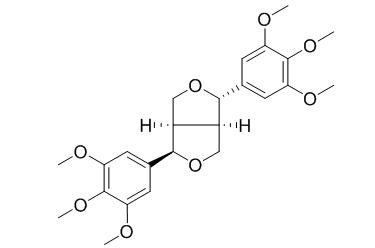Epiyangambin
Epiyangambin is a phytotoxic lignan, it shows inhibition of seed germination of Agrostis stolonifera cv. penncross (Poaceae) and inhibition of development of Lactuca sativa L. (Asteraceae) seedlings in a microassay using 24-well plates. Epiyangambin exhibits significant inhibition of the transformation of murine epidermal JB6 cells, with the IC50 value of 0.15 microg/mL. (+)-Epiyangambin also has anti-platelet aggregation activity.
Inquire / Order:
manager@chemfaces.com
Technical Inquiries:
service@chemfaces.com
Tel:
+86-27-84237783
Fax:
+86-27-84254680
Address:
1 Building, No. 83, CheCheng Rd., Wuhan Economic and Technological Development Zone, Wuhan, Hubei 430056, PRC
Providing storage is as stated on the product vial and the vial is kept tightly sealed, the product can be stored for up to
24 months(2-8C).
Wherever possible, you should prepare and use solutions on the same day. However, if you need to make up stock solutions in advance, we recommend that you store the solution as aliquots in tightly sealed vials at -20C. Generally, these will be useable for up to two weeks. Before use, and prior to opening the vial we recommend that you allow your product to equilibrate to room temperature for at least 1 hour.
Need more advice on solubility, usage and handling? Please email to: service@chemfaces.com
The packaging of the product may have turned upside down during transportation, resulting in the natural compounds adhering to the neck or cap of the vial. take the vial out of its packaging and gently shake to let the compounds fall to the bottom of the vial. for liquid products, centrifuge at 200-500 RPM to gather the liquid at the bottom of the vial. try to avoid loss or contamination during handling.
University of Central Lancashire2017, 20472
Front Microbiol.2023, 14:921653.
Agriculture2024, 14(12), 2301
J Chromatogr B Analyt Technol Biomed Life Sci.2020, 1149:122123.
In Vivo.2022, 36(3):1136-1143.
Biomedicines.2021, 9(8):954.
Toxicol In Vitro.2019, 59:161-178
Int J Biol Macromol.2021, 199:189-200.
J Enzyme Inhib Med Chem.2019, 34(1):134-143
Int J Mol Med.2016, 37(2):501-8
Related and Featured Products
J Nat Prod. 2002 Jul;65(7):1065-8.
Constituents of the twigs of Hernandia ovigera that inhibit the transformation of JB6 murine epidermal cells.[Pubmed:
12141878]
METHODS AND RESULTS:
Activity-guided fractionation of an ethyl acetate extract of the twigs of Hernandia ovigera, using a soft agar assay with JB6 murine epidermal cells, led to the isolation of two new naturally occurring aryltetralin lignans, (7R,8S,7'R,8'R)-(+)-7'-acetyl-5'-methoxypicropodophyllin (1) and (7R,8S,7'R,8'R)-(+)-7'-acetylpicropodophyllin (2), of which 2 was previously identified as a synthetic product, along with eight known compounds, Epiyangambin (3), caruilignan C, diasesartemin, (+)-epimagnolin A, N-methylcorydaldine, (-)-5'-methoxyyatein, (+)-syringaresinol dimethyl ether, and (-)-yatein. The structures and stereochemistry of 1 and 2 were determined using spectroscopic methods.
CONCLUSIONS:
Compounds 2 and 3 exhibited significant inhibition of the transformation of murine epidermal JB6 cells, with IC50 values of 0.15 and 0.4 microg/mL, respectively, while the other isolates were regarded as inactive (IC50 >4 microg/mL).
Nat Toxins. 1999;7(1):39-43.
Phytotoxic lignans of Leucophyllum frutescens.[Pubmed:
10441036]
METHODS AND RESULTS:
Bioassay-guided fractionation of the hexane:ethyl acetate (1:1) extract of the leaves of Leucophyllum frutescens (Berl.) I.M.Johnst (Scrophulariaceae) led to the isolation of its phytotoxic constituents diayangambin (1), Epiyangambin (2), diasesartemin (3) and epiashantin (4). Phytotoxicity was demonstrated as inhibition of seed germination of Agrostis stolonifera cv. penncross (Poaceae) and inhibition of development of Lactuca sativa L. (Asteraceae) seedlings in a microassay using 24-well plates. Compound 1 was the most phytotoxic to L. sativa, showing strong inhibitory activity at 110 microM. Compound 1 was more active than 2 and 3 in inhibiting the growth of A. stolonifera with I(50) values of 160, 670 and 930 microM, respectively.
CONCLUSIONS:
At a concentration of 500 microM, these compounds inhibited all phases of onion root cell division. This is the first demonstration of antimitotic activity of these furofuran lignans, and the first report of their isolation from this species.
Planta Med. 2000 Apr;66(3):251-6.
Anti-platelet aggregation alkaloids and lignans from Hernandia nymphaeifolia.[Pubmed:
10821052]
METHODS AND RESULTS:
A new aporphine, N-(N-methylcarbamoyl)-O-methyl-bulbocapnine (1), together with seven known compounds, (-)-5'-methoxypodorhizol (2), a mixture of beta-sitosterone (3) and stigmasta-4,22-dien-3-one (4), a mixture of 3 beta-hydroxystigmast-5-en-7-one (5) and 3 beta-hydroxystigmasta-5,22-dien-7-one (6), and a mixture of 6 alpha-hydroxystigmast-4-en-3-one (7) and 6 alpha-hydroxystigmasta-4,22-dien-3-one (8), were isolated in continuing studies on the trunk bark of Formosan Hernandia nymphaeifolia.
CONCLUSIONS:
The structures of these compounds were determined through spectral analyses. In addition, the previously reported six alkaloids, laurotetanine, oxohernagine, thalicarpine, reticuline, (+)-vateamine-2'-beta-N-oxide, (+)-hernandaline and six lignans, (+)-epiaschantin, (+)-epimagnolin, (+)-Epiyangambin, (-)-hernone, (-)-yatein, (-)-deoxypodophyllotoxin were demonstrated to have anti-platelet aggregation activity.



